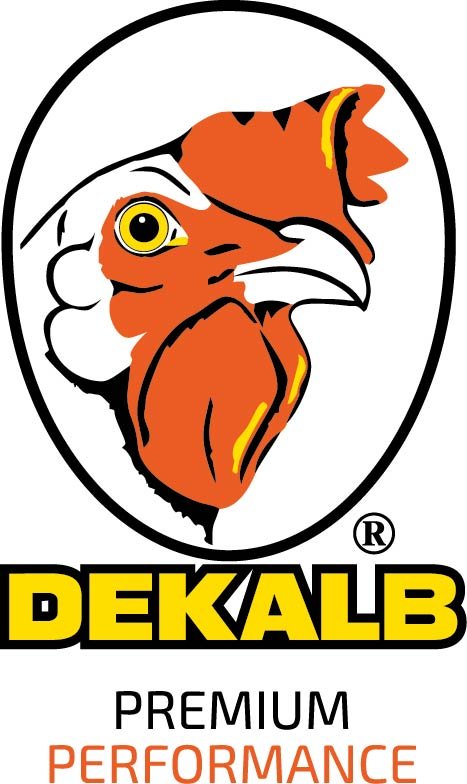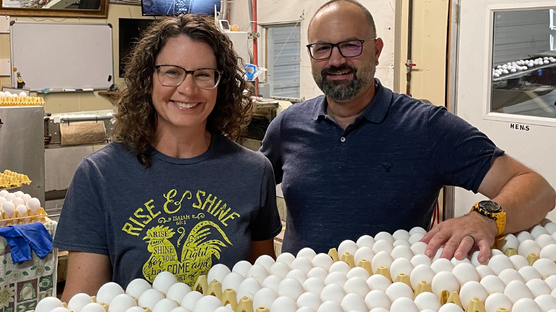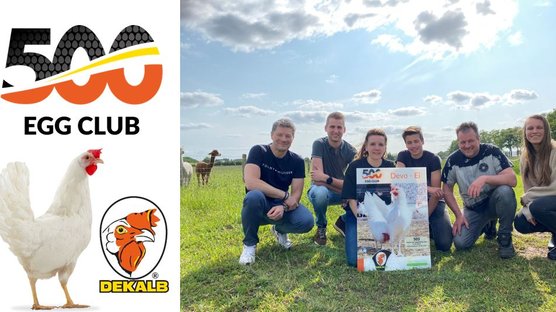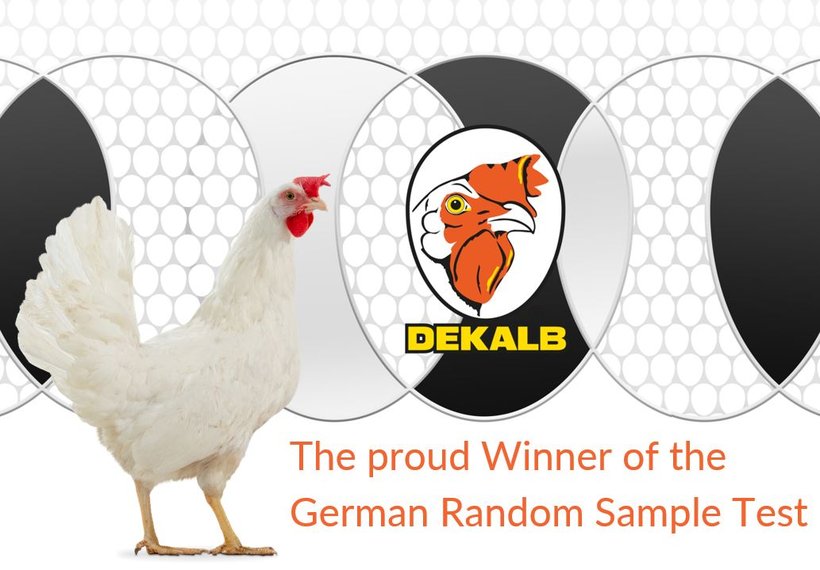
Published on Nov. 14, 2022
The Dekalb did it once again!
The results of the balanced Breeding program of Hendrix Genetics are clearly showing of in todays’ market. The Dekalb White participated in the 16th Random Sample Test of layer hybrids in cage-free housing systems in Germany (the Bayerischer Herkunftsvergleich von Legehybriden in Bodenhaltung). Whether it is eggs hen housed, hen day, feed conversion, egg mass, livability or egg shell quality, the Dekalb has it all!
Let’s look into more detail at the Random Sample Test to discover more on the premium performance of the Dekalb.
Building the potential in the rearing period
At arrival in the rearing barn the chicks have been divided over 6 compartments (2 per breed). They have been reared in the Big Dutchman NATURA Filia system, which is a two-level rearing aviary. Chick bridges and ramps were present to help the birds to get from the system to the litter areas, and to move from one tier to another. The intermediate level inside the aviary increases the surface area of the system, ensuring sufficient room during the entire rearing period. The Dekalb showed highest bodyweights at both 8 and 16 weeks of age, accompanied by high uniformity. No differences in overall feed intake have been recorded between the 3 breeds, but when we look at mortality during the rearing period, differences are there. The LSL Classic shows more than 3 times higher mortality, and for Novogen almost 4 times as high! Selecting for livability is and has been for many years a key trait in the Hendrix-Genetics Breeding Program. As beak-trimming is prohibited in Germany, all birds were kept with fully intact beaks.
| Breed |
Bodyweight (grams / bird) |
Bodyweight (grams / bird) |
Uniformity of BW as % |
Uniformity of BW as % |
Feed Intake | Mortality |
|---|---|---|---|---|---|---|
| 8 weeks | 16 weeks | 8 weeks | 16 weeks | Kg/bird | % | |
| Comp. 1 | 567 | 1179 | 64 | 91 | 6,7 | 5 |
| Comp. 2 | 569 | 1173 | 71 | 91 | 6,7 | 6 |
| Dekalb White | 607 | 1196 | 77 | 97 | 6,7 | 1,6 |
During the rearing period the goal is to build the basis for the productive life of the laying hens. A good appetite will help to develop a good frame and the reproductive organs which are key for maintaining high persistency and overall condition later in life. A step-down (10 hours of light at plateau) and step-up (15 hours of light at 24 weeks) lighting program was used to steer the flock towards the peak of egg production.
Reaching the Genetic Potential
At 18 weeks of age, the birds were transferred from the rearing to the production house. The 3 different breeds were divided over 12 compartments (4 per breed). Each compartment consisted of Family nests (Fienhage), plastic slatted floors (Big Dutchman), and a scratching area. Feed was available ad libitum to the flock, and from each pen total feed intake was calculated. Egg production and mortalities have been recorded on a daily base, in the case of conspicuous animal losses, the determination of the cause of death was performed by the central laboratory of the Bavarian Animal Health Service. Egg quality research was conducted in their own research laboratory, measuring Haugh Units, eggshell breaking strength, and egg weights at various time points during the productive life.
When we expanded our breeding program almost 15 years ago, we had a clear goal in mind, to increase the total amount of 1st quality eggs produced for each hen housed. When looking to the total number of saleable eggs in the table below, you can see that our breeding efforts are definitely paying off. More than 13 saleable eggs more for each hen housed versus the LSL Classics, and almost saleable 20 eggs more when compared to the Novogen White. The premium performance in productivity of the Dekalb is proven here!
| Age at 50% lay | Eggs Hen housed | # saleable eggs | % lay hen housed | eggmass HH | Feed consumption HH | daily feed intake HD | Feed Conversion | |
|---|---|---|---|---|---|---|---|---|
| Comp. 1 | 153 | 326,9 | 286,4 | 89,8 | 21,3 | 44,9 | 126,7 | 2,108 |
| Comp. 2 | 152 | 320,9 | 279,8 | 88,1 | 20,2 | 42,6 | 123,7 | 2,105 |
| Dekalb White | 151 | 340,6 | 299,6 | 93,6 | 21,4 | 42,8 | 118,7 | 1,999 |
It’s all about first quality eggs
Not only the number of eggs that each laying hen produces contributes to the profitability of your egg farm, but especially the quality plays a major role to make money. Via our balanced breeding approach, we focus on both internal and external egg quality, and this all the way towards the end of the laying cycle. Our layers breeds do not only start at a very competitive level, they are also able to maintain egg quality towards the end, as the gap with their competitors is growing when the birds are getting older. Persistency in lay, persistency in egg quality and persistency in livability all contribute to these great achievements. Our breeding focus on flat egg weight curves allows our layer breeds to better utilize their resources to produce 1st quality eggs, and it allows them to be more persistent. All contributing towards the sustainability of the global egg sector!
| Dirt eggs | Broken eggs | 2nds % | BS 42 wks | BS 67 wks | Haugh Units 42 wks | Haugh Units 67 Wks | |
|---|---|---|---|---|---|---|---|
| Comp. 1 | 1,1 | 1,7 | 2,8 | 47,4 | 36,4 | 89,3 | 84 |
| Comp. 2 | 0,8 | 2 | 2,8 | 44,5 | 34,7 | 91,1 | 86,3 |
| Dekalb White | 0,9 | 1,6 | 2,5 | 47,4 | 36,8 | 92,8 | 89 |
Focus on Animal Welfare
Intensive assessments on Animal Welfare parameters have been conducted as well. Scoring of the plumage cover, lesions on skin and toes, foot condition, and keel bones took place at various ages. The incidence of damage are often indirectly and indicator of behavioral abnormalities. The Dekalb showed the best ranking (i.e. lowest incidence) on all four welfare parameters towards the end. Next to poorer feather cover, higher prevalence of toe conditions and lesions and more keel bone damage, the competitors also showed higher mortalities. Where the LSL-Classics showed more than 3 times as high mortality, the Novogen Whites showed even 6 times as high mortality compared to the Dekalb. Imagine, that’s a whole load of extra labor and loss of eggs and therefor income.
| infection | cannibalism | toe pecking | accident | other | Total | |
|---|---|---|---|---|---|---|
| Comp. 1 | 0,6% | 1,1% | 1,7% | 0,2% | 1,1% | 4,7% |
| Comp. 2 | 1,1% | 2,8% | 3,0% | 0,2% | 2,6% | 9,6% |
| Dkalb White | 0,2% | 0,4% | 0,6% | 0,0% | 0,2% | 1,5% |
True Premium Performance
When looking to the results in more detail, we can conclude that the Dekalb White show premium performance in cage-free housing systems. We are proud to see that the hard work from all our employees at the breeding departments are clearly paying off, and have resulted in a laying hen that is able to perform well and that shows excellent behavior towards her fellow group members, resulting by far in the lowest mortality and highest quality all the way to the end of the laying cycle.
The data that is used in this article is derived from the official report made by the Bayerische Staatsgüter, Landwirtschaft gestalten published in June 2022.
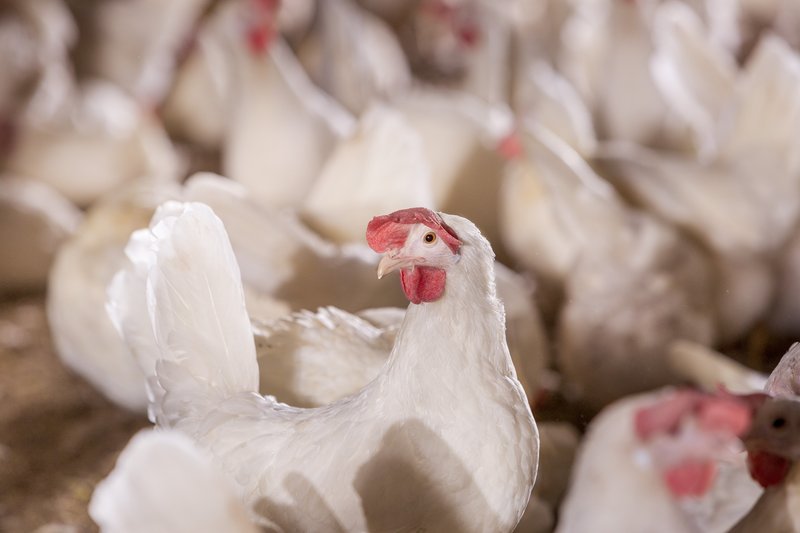
Vaccination Schedule
| Age of vaccination | Vaccination against |
|---|---|
| 1. day | Mareks Disease (MD) |
| 2. days | Salmonella Enteritidis + S. Typhimurium (SE+ST) |
| 6. days | coccidiosis |
| 3. weeks | Gumboro (IBD) |
| 4. weeks | Infectious Bronchitis (IB) / Newcastle Disease (ND) |
| 7. weeks | Salmonella Enteritidis + S. Typhimurium (SE+ST) |
| 8. weeks | Newcastle Disease (ND) |
| 9. weeks | Infectious Bronchitis (IB Ma 5) |
| 10. weeks | Mycoplasma synoviae (MS) |
| 11. weeks | Avian Encephalomyelitis (AE) |
| 14. weeks | Infectious Bronchitis (IB Ma 5) |
| 16. weeks | Newcastle Disease (ND) |
| 18. weeks | Salmonella Enteritidis + S. Typhimurium (SE+ST) |
| 20. weeks |
Inactivated-Vaccine: Newcastle Disease (ND) + Infectious Bronchitis (IB) + Egg Drop Syndrome (EDS) + ART (Avian Pneumovirusinfection) |
